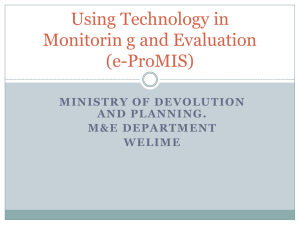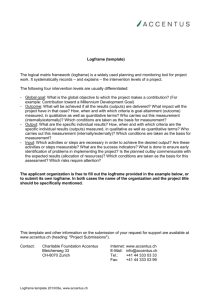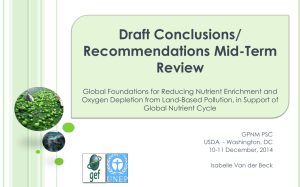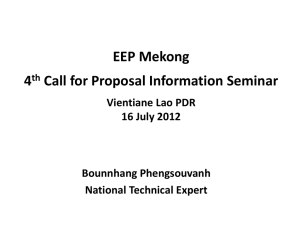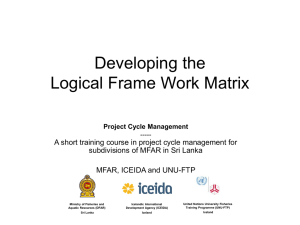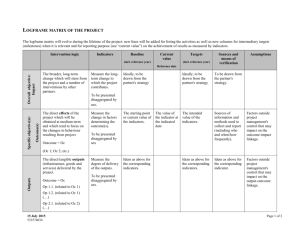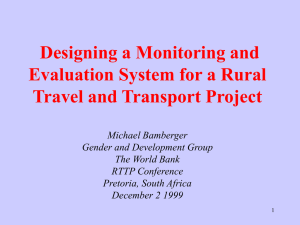Designing Projects and Project Evaluations Using The Logical Framework Approach
advertisement
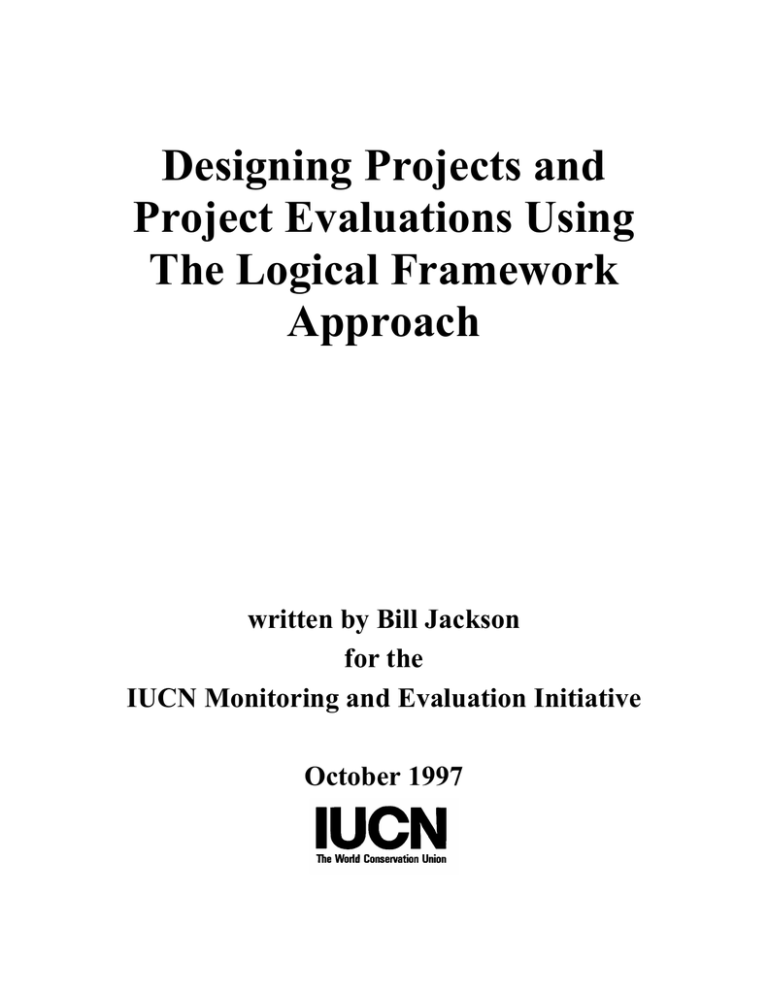
Designing Projects and Project Evaluations Using The Logical Framework Approach written by Bill Jackson for the IUCN Monitoring and Evaluation Initiative October 1997 Founded in 1948 as the International Union for the Conservation of Nature and Natural Resources, the IUCN - the World Conservation Union, brings together States, Government agencies and a diverse range on non-government organisations in a unique world partnership: over 800 members in all, spread across some 136 countries. As a Union, IUCN seeks to influence, encourage and assist societies throughout the world to conserve the integrity, and diversity of nature and to ensure that any use of natural resources is equitable and ecologically sustainable. The Union builds on the strengths of its members, networks and partners to enhance their capacity and to support global alliances to safeguard natural resources at local, regional and global levels. The views expressed in this guideline do not necessarily reflect those of IUCN. Neither do the presentation of material and geographic designations employed imply any expression of opinion whatsoever on the part of IUCN concerning the legal status of any country, territory or area, concerning the delimitation of its frontiers and boundaries. About the IUCN M&E Initiative This publication is a contribution to the work of the IUCN Monitoring and Evaluation (M&E) Initiative. Developed in 1996 as a response to the 1994 and 1996 External Reviews of IUCN, the M&E Initiative aims to improve IUCN’s capacity to learn from experience by: • improving our use of methods and tools in project, systems and institutional assessment. • developing a reflective culture within IUCN. • improving project and programme design, implementation and M&E. • improving the policy - field feedback loop. • improving our communications and reporting of lessons learned. This is being done through a facilitated approach working in four pilot regions - East and Southern Africa, Central and South America. Bill Jackson was the facilitator for East and Southern Africa during 1996 and is currently the Head of the Forest Programme at IUCN HQ. He uses the approach to logical frameworks described in this paper. For more information please contact the IUCN M&E Initiative, Rue Mauverney 28, Gland, 1196, Switzerland. Fax: 41 22 999 0025; Phone: 41 22 999 0001. Email: Mail@hq.iucn.org This paper is also on the IUCN Website: http://www.iucn.org/themes/ssp/index.html 2 Designing Projects and Project Evaluations Using The Logical Framework Approach Bill Jackson 1997 Introduction Volumes having been written on project design and planning, yet there is not, and most likely never will be, a blueprint for designing and evaluating projects. Project designs vary from simple ‘desk-top’ designs to complex exercises involving complex partnership arrangements. Designs can be brief, uncomplicated exercises that last only hours or long complex procedures that involve many cycles of planning, reviewing and adjusting. This guideline is designed to assist IUCN`s secretariat and members understand the logical framework approach to project design and evaluation. Effective project design The logical framework (or logframe) approach provides a set of designing tools that, when used creatively, can be used for planning, designing, implementing and evaluating projects. Logframes provide a structured, logical approach to setting priorities and determining the intended results and activities of a project. Used correctly, logframes can provide a sound mechanism for developing a project concept into a comprehensive project design document. Logframes can also provide the basis for evaluating the effectiveness, efficiency and relevance of a project. There are a variety of approaches to logframes. Many of the institutions involved in conservation and development activities have particular approaches to logframes. This paper does not argue that one approach is better than another, but provides a generic approach that can be adapted to suit the needs of the user or donor agency. The logframe approach usually consists of an analysis and a planning phase, each phase has three steps as shown below (adapted from ITAD, 1996). Analysis Phase ⇒ ⇒ ⇒ ⇒ Planning Phase • Analysis of problems • Logframe matrix • Analysis of objectives • Activity Schedule • Analysis of strategies • Input and cost schedule 3 Before describing the logframe approach it is worth considering (a) the weaknesses of the approach and (b) what needs to be undertaken before a logframe can be developed. Weaknesses with Logical Frameworks Logframes provide a valuable set of tools for project designing, but they also have a number of weaknesses. Such weaknesses include, but are not limited to the following: • One of the main criticisms that project designers have of the logframe approach is that it begins by identifying problems. Such an approach: • Often produces poor results because the initial negative focus pervades the rest of the logframe process. This often results in limited vision of potential solutions. • Can be a particularly serious problem in cultures that consider it inappropriate to openly discuss problems or criticise. • Is not suited to situations where there is a great deal of uncertainty or where agreement cannot be reached on the main problem. The logframe approach assumes the nature of the problems can be readily determined at the beginning of the planning process. This does not allow for an exploratory style project that seeks to learn from experience. • The logframe is often developed and used rigidly. This can stifle innovative thinking and adaptive management. • Logframes are often developed after the project has been designed rather than used as the basis for design. The use of the logframe late in the design process can often be attributed to: • a lack of understanding of the logframe approach. • the logframe is seen as a requirement of funding agencies and not as a design or management tool. • Logframes do not readily enable monitoring unintended consequences. • Logframes are rarely considered by project managers to be a key planning tool. Situation Analysis Before the logframe approach can be used the situation of the proposed project or programme needs to be analysed. Answers to the following questions are needed: • What are the general areas of concern, or themes, that the project will focus on? • What is the project aiming to achieve? • At what spatial levels will the project focus, in terms of subject (broad/macro to specific/micro) and or geography (local to global)? • What political, socio-economic, technological and biophysical environment will the project operate within? 4 • Who are the major stakeholders? • How will stakeholders be involved in the process of design, implementation, monitoring, evaluation and reporting? • Who is working on the issues already? What are they doing? • What is the niche of the project? • Who will implement the project? • What is the intended duration of the project? • What is the anticipated level of funding? • Who will fund the project? Before a logframe can be developed the answers to many or all of these questions need to be collected, synthesised and analysed. In addition, the project needs to be placed in the context of the following four areas of concern: • The historical background of issues relating to the proposed project; • The current situation; • The needs and interests of various stakeholders; and • Future options. For projects involving simple issues the information collection, synthesis and analysis stage is often very brief. In other instances, where the project is complicated, the information collection, synthesis and analysis stage requires intensive efforts that can take years. Getting Ready for the Logical Framework Workshop Ideally the logical framework analysis should be undertaken in a workshop situation which includes key stakeholders. However, more often than not, the logical framework is developed by a consultant or staff member in isolation from other stakeholders. This latter approach should be avoided where possible. Before commencing the logframe workshop the above preliminary steps should be complete and the following issues should be considered: • Who will be involved in the logframe workshop? • Where will the workshop conducted? • Who will facilitate the workshop? What background materials, papers and expertise may be needed for the workshop? • What materials and logistics are required? In some situations more than one round of logical framework analysis may be needed. This is particularly the case where there are large differences of opinion between stakeholders. Such differences can be geographic, social, economic or political. For 5 example, a project may be focused on assisting village communities to manage natural resources while operating simultaneously at district, regional and national levels. Bringing stakeholders together from the national policy level to the resource user level in a single logframe exercise is unlikely to be feasible or productive. An alternative approach involves using a participatory approach to planning at the village level which feeds into a series of logframe workshops at the higher levels. The outcomes of the participatory planning exercises and workshops can be fed into an overall project logframe workshop at the national level involving key stakeholders national, regional, district and grassroots organisation levels. The Analysis Phase The logframe approach begins by analysing the existing situation and developing objectives for addressing real needs. The analysis phase is the most critical, yet most difficult, phase of the logframe approach. The analysis phase consists of three stages, analysis of problems, analysis of objectives and analysis of strategies. The Analysis of Problems The analysis phase usually begins with an analysis of problems. However, beginning the process with an analysis of problem can produce poor results as it focuses on negative issues to begin with. This can be a particularly serious problem in cultures that consider it inappropriate to openly discuss problems or criticise. An alternative is to begin by formulating objectives, this is discussed below. The problem analysis is undertaken by identifying the main problems and developing a ‘problem tree’ through an analysis of cause and effects. Identifying the main problem Brainstorming techniques are used to identify the main problems. Before the brainstorming exercise commences it is important that the facilitator explain the process and the group agrees on some rules for brainstorming. An example of brainstorming rules • All ideas are accepted without argument • Aim for quantity rather than quality • No debate about whether ideas are accepted or not, only about whether the idea has already been listed. • No evaluation now (limit the discussion on the significance of the material and concentrate on getting full cross-section of ideas) 6 For maximum participation, brainstorming groups should be no more than ten or twelve people. For larger groups it is better to split the group into smaller groups. The brainstorming exercise commences by asking workshop participants to identify the main problems that the project will address. The main problems should be written on small pieces of card, post-it notes, or paper and stuck on the wall. Wherever possible high order problems should not be described as ‘lack of’ something, for example lack of knowledge, but instead they should be described as an effect, for example lack of knowledge may become ‘destructive forest harvesting practices’. After all of the problems are displayed on the wall they should then be clustered into groups of similar issues. Problems that are duplicated can be discarded. At this stage a simple ‘weeding’ exercise can be undertaken. The aim of the weeding exercise is to remove any problems that are clearly not problems that can be addressed by the project. Developing the problem tree The problem tree is developed by moving problems from the clusters of problems on the wall and by adding new problems that emerge as the tree is developed. Problems can be moved up or down the tree as required. The tree should end up with one main problem and a series of lower order problems that branch out below the main problem. The easiest way to develop the problem tree is to begin with a ‘starter’ problem and progressively add the other listed problems to the tree. It does not really matter which problem is chosen as the starter problem but it is best if it is a problem that participants agree is of major importance. The problem tree is constructed by selecting a problem from the list and relating this problem to the starter problem using the cause-effect rationale described below: • If the problem is a cause of the starter problem it is placed below the starter problem; • If the problem is an effect of the starter problem it goes above; • If it is neither a cause or effect it goes at the same level. An example of a problem tree is shown below. 7 Figure 1 A simple problem tree (from IUCN, 1997) Effect Loss of biodiversity Decreasing number of elephants Human/ elephant conflicts Overpopulation by people Hunting/ poaching Decreasing number of varieties of maize No adequate legislation Monopoly of seed trade Pesticide Cause Objectives Analysis The problem tree is transformed into an objectives tree by restating the problems as objectives. ITAD (1996) describe the objectives tree as the positive mirror image of the problem tree. It is usually necessary to reorder the position of objectives as you develop the tree. The objectives tree can also be considered as an ‘ends - means’ diagram. The top of the tree is the end that is desired and the lower levels are the means to achieving the end. An example of an objectives tree is shown below. Figure 2 An objectives tree (from IUCN, 1997) Improve or increase biodiversity Ends Sustain elephant population at optimum levels Means Establishing economic incentives for local populations to protect elephants Effective human population programme Sustain elephant population at optimum levels Efficient means of controlling poaching Good legislation Strategy Analysis The strategy analysis involves clustering objectives and examines the feasibility of different interventions (ITAD, 1996). The main objective becomes the project purpose and the lower order objectives become the outputs or results and activities. ITAD (1996) state … “the final stage of the analysis phase involves the selection of a strategy to achieve the desired results. The strategy comprises the clusters of objectives 8 to be included in the project. In addition to examining the logic, strategy analysis also looks at feasibility of different interventions. This may mean that the focus of the project shifts, therefore once the strategy has been selected, the project purpose and overall objectives are finalised.” An example of a strategy analysis is shown below. In this example it is unlikely that IUCN would choose “efficient human population programme” but rather one or all of the other means. The process of making choices should be carried out in a very methodical way, giving due consideration to the ends/means relationship in the objectives tree (IUCN, 1997). Figure 3 A strategy (adapted from IUCN, 1997) Improve or increase biodiversity Overall objective Sustain elephant population at optimum levels Project purpose Results or outputs Establishing economic incentives for local populations to protect elephants Efficient means of controlling poaching Sustain elephant population at optimum levels Good legislation Activities Testing the logic of the tree There are a number of tools that can be used to test the logic of the objectives tree and to identify strategies. Three tools are described below. The intent structure analysis The intent structure is a tool from systems methodology, adapted from systems engineering. Lee-Smith (1997) describes it as an ‘ends-means’ diagram that portrays the values, goals, objectives and detailed actions of components of an organisation, program, project or purposeful system. The intent structure is shown below. The logic of the tree is tested by starting at the top of the hierarchy and asking the question how is each level in the hierarchy to be achieved, and or by starting at the bottom of the hierarchy and asking the question “why is this objective/action being undertaken”. 9 Figure 4 The Intent Structure (adapted from Lee-Smith, 1997) End Value or vision Why is this to be done? The level above is the end for which the level below is undertaken How is this to be done? Overall Objectives Why is this to be done? How is this to be done? Specific Objectives or Purposes The level below is the means by which the level above is achieved Why is this to be done? How is this to be done? Expected Results or Outputs Why is this to be done? How is this to be done? Specific Activities Means Force Field Analysis Force field analysis is a simple approach that is used to develop a list of the factors that may promote or inhibit reaching the goals and objectives of the project. The aim of force field analysis is to provide a model for encouraging the participants to: • Examine current characteristics of the present state or situation; • Develop a list of positive and negative forces influencing the achievement of the goals and objectives; • Discuss the means to strengthening the positive forces and overcoming the weak forces sought. A graphical representation of the force field analysis is shown below: Figure 5 Force Field Analysis 10 Goals Negative Forces Positive forces Current Problems SWOT SWOT (Strengths, Weaknesses, Opportunities and Threats) analysis is widely used as tool for exploring the constraints and opportunities of a proposal. It can be used to test the completeness of a goal. Strengths and weakness refer to those strengths and weaknesses within the project. Opportunities and threats refer to the opportunities for and the threats to the project achieving the goal. An Alternative Approach to the Analysis Phase An alternative approach to the analysis phase is to use the search conference approach. Crombie (1983: 9) describes the search conference as a methodology of participatory planning that involves groups searching future possible environments for a more desirable future. The search conference process involves generating information and ideas through diverging techniques (brainstorming), synthesis and analysis of ideas and finally to planning future actions (Crombie, 1983: 9), see figure 6. Figure 6 The search conference approach Focus on desirable and possible futures Generate ideas about nature of situation (brainstorming) Analyse and prioritise issues Plan for action 11 The Planning Phase The logframe matrix is developed from the strategy analysis by filling in the columns of the matrix as shown below. The objectives, purpose, outputs/results and activities are transposed from the strategy tree to the columns and rows in the matrix. Figure 7 indicates the approach to preparing a logframe and indicates the sequence for completing the logframe. ITAD (1996) suggest that when used properly the logframe helps to make logical relationships between activities, results, purpose and objectives more transparent. Figure 7 The logical framework matrix Objectives/activities Indicators Means of verification Assumptions 1 Overall Objectives 15 Indicators 16 Means of verification 8 Assumptions 2 Project Purpose 13 Indicators 14 Means of verification 7 Assumptions 3 Results 11 Indicators 12 Means of verification 6 Assumptions 4 Activities 9 Means and Indicators 10 Costs and Means of verification 5 Assumptions Assumptions The aim of specifying the assumptions is to identify the external factors that will affect the success of the project. Once assumptions have been identified, they are stated in terms of the desired situation (ITAD, 1996). Examples of assumptions may be (from ITAD, 1996): • Land distribution is completed in a timely manner; • Local institutions collaborate in planning activities; • Suitable staff are identified and recruited; • Adequate budget allocations are made; • Government meets certain preconditions set by the donor. ITAD provides an assumptions algorithm shown in figure 8. 12 Figure 8 The Assumption Algorithm (ITAD, 1996) Is the external factor important? YES NO Almost certainly Will it be realised? Likely Do not include in logframe Include as an assumption Is it possible to redesign the project in order to influence the external factor? Unlikely YES NO Redesign the project: add activities or results; or reformulate the project purpose The project is not technically feasible Objectively Verifiable Indicators For each output and activity indicators need to be developed. Objectively verifiable indicators or OVI should meet the following criteria: Measurable An indicator must be able to be measured in either quantitative or qualitative terms Feasible An indicator should be feasible in terms of finances, equipment, skills and time available Relevant and Accurate An indicator should reflect what we are trying to measure in an accurate way Sensitive An indicator should be capable of picking up changes over the time period that we are interested in and Timely An indicator should be able to provide information in a timely manner 13 At this stage in the logframe process there is often a tendency to include large numbers of indicators on the assumption that more information is better than less information. Prescott-Allen (1997) differentiates between performance indicators and descriptive indicators. Performance indicators measure the achievement of objectives. For example, the % annual change in forest area; life expectancy at birth. Descriptive indicators measure phenomena that may influence objectives but which the objectives are not expected to change. For example, national monthly rainfall index; ethnic composition of population. Prescott-Allen (1997) provides the following details about indicators: • Performance indicators measure results and responses. • Results are more convincing indicators than responses. • The more direct the indicator the more reliable it will be. • Conditions or states are the most direct measures of results. • Pressures are strong substitutes for conditions/states. • Responses are weak substitutes for conditions/states. He continues, a high quality performance indicator: • Relates to an explicit objective. • Accurately and unambiguously reflects the degree to which the objective is met. • Is measurable. • Depends on data that are either readily available or obtainable at reasonable cost. • Is analytically sound and uses standardized measurement wherever possible to permit comparison. • Shows trends over time and is responsive to changes in conditions and sensitive to differences between places and groups of people. Indicators of Equity and Gender Indicators should show who is benefiting from the project and allow for evaluation of the intended and unintended impacts of the project on various social groups and stakeholders. This requires the collection of information separately for men and women, for different ethnic groupings, for different age groupings (children, adults, elderly) and for different economic (rich, poor) and social groupings (agriculturalists, pastoralists, businesses). Means of Verification Once indicators have been developed, the source of the information and means of collection (means of verification (MOV)) should be established for each indicator. An 14 MOV should test whether or not an indicator can be realistically measured at the expense of a reasonable amount of time, money and effort. The MOV should specify: • The format in which the information should be made available (e.g. reports, records, research findings, publications). • Who should provide the information. • How regularly it should be provided (adapted from ITAD, 1996). Means and Costs and Activity Schedules Once the logframe matrix has been completed the details should be transferred to an activity schedule and costs for each activity assigned to determine a budget. Gantt Charts can be used to develop a schedule of activities. Cost Schedules should be prepared as a basis for project budgeting. Such budgets should match with the logframe and build in funds for evaluation. Using Logical Frameworks for Project Evaluations ITAD (1996) suggest that ‘the logframe approach remains a powerful management tool for analysis of project design’. The difference between using a logframe approach for designing a new project and analysing an existing project is that the analysis phase uses existing project documentation instead of primary data sources. The following sequence for using a logframe approach for evaluating an existing project is based on ITAD (1996): • Mark the problems listed in the project documents • Use these problems to build a problem tree • Reformulate the problems into objectives • Mark the objectives listed in the project documents • Compare the objectives listed in the document with the reformulated problems • Build an objectives tree, identifying the following: • objectives that are identified in the documents and by the review team • objectives that are identified by the review team but not in the document • objectives that are identified in the document but not by the review team • Analyse inconsistencies in project design • problems not addressed by objectives • objectives for which no corresponding problem was identified • differences in cause-effect/means-ends relationships between the problem tree and objective tree Logframes can also be developed for existing projects that have been designed without a logframe or where the logframe is inadequate for evaluating the project or for use in 15 project implementation. In this situation the analysis phase can be shortened by using the existing project objectives and developing a logical framework matrix. Conclusions The logical framework approach provides a powerful set of tools for designing projects and project evaluations. However, like all tools, logframes are not the complete answer to effective project designing. Logframes are best used towards the end of the project design cycle after information has been collected and analysed, needs assessed, views of stakeholders sought and the external environment of the project understood. In situations where the problem identification stage is likely to be a problem in itself, the search conference and the intent structure may be more appropriate approaches for the analysis phase. References This publication draws on the following publications: Crombie (1983) Search Conferencing. ITAD Ltd (1996) “the logical framework approach - a project management tool”. ITAD London IUCN (1997) Draft PDG Guidelines: A guide to the development, review and further processing of projects in IUCN. IUCN Switzerland Prescott-Allen R. (1997) The Barometer of Sustainability. IUCN Switzerland. USAID (1994) GENESYS Gender in Monitoring and Evaluation: A Tool for Developing Project M&E Plans. USAID Washington DC 16
